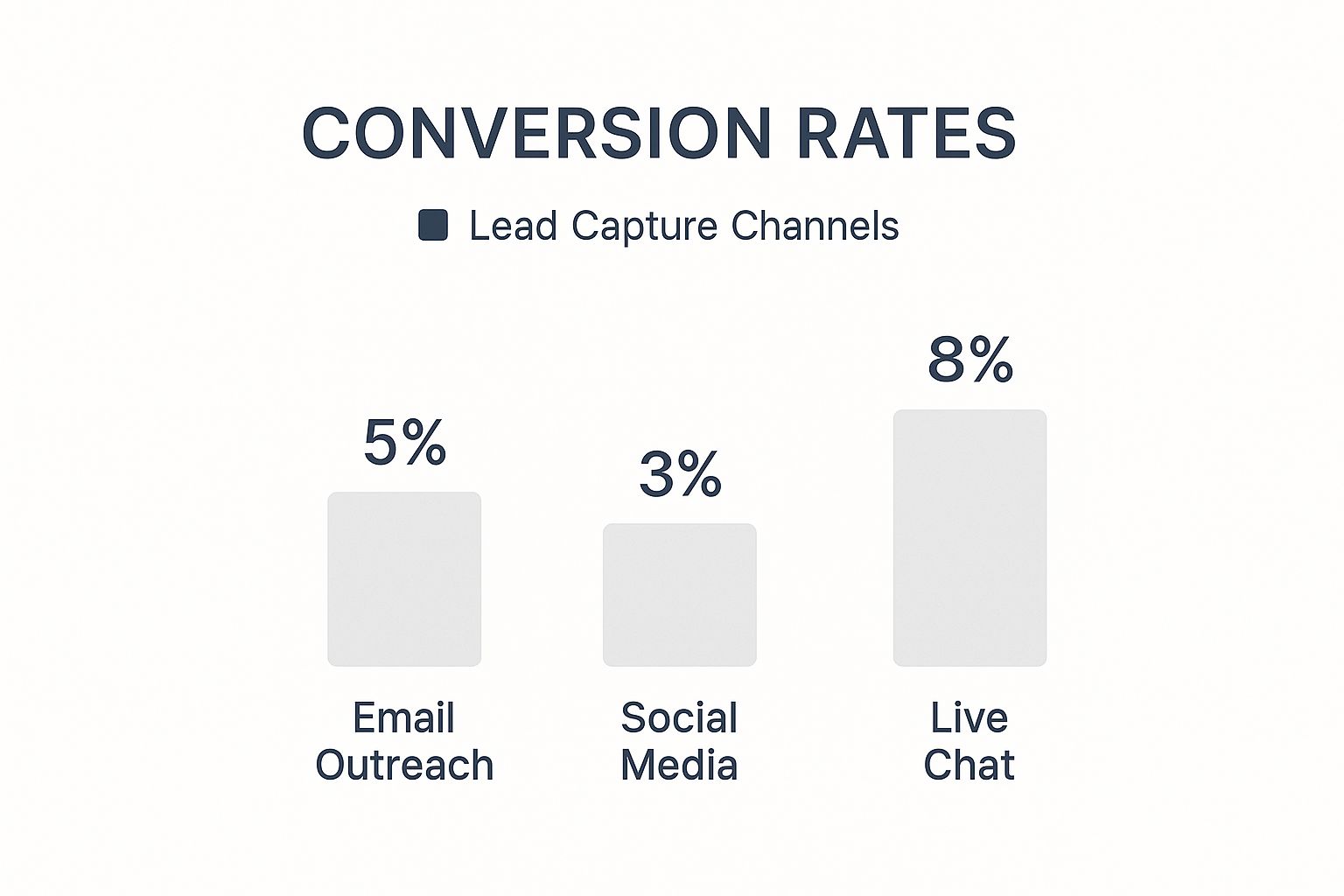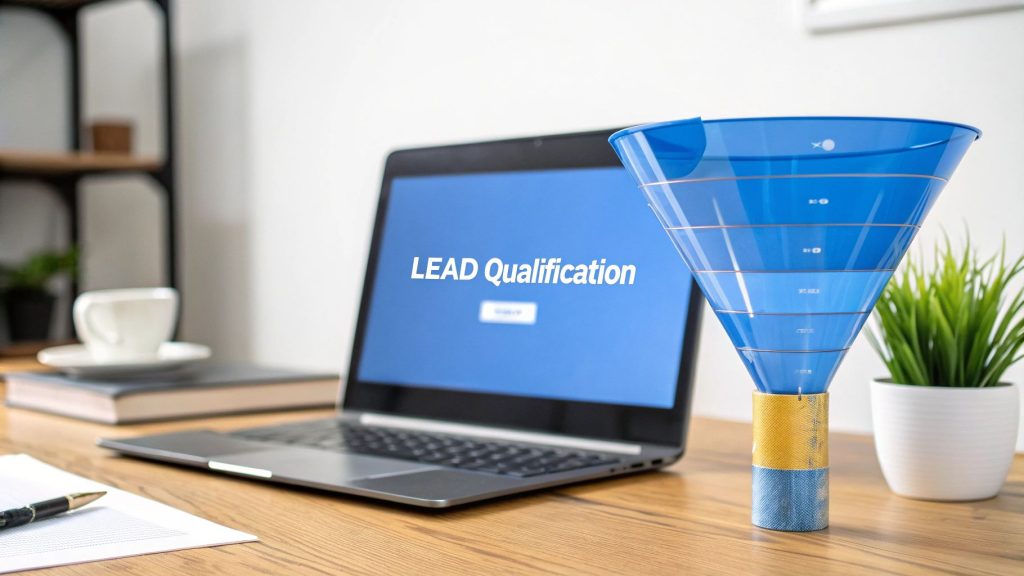Why Qualification Matters Now

Generating leads is essential, but it’s only the first step in selling. Imagine casting a wide fishing net. You might catch a lot, but are they the right kind of fish? Lead qualification is about separating the promising prospects from those who aren’t likely to convert, helping your sales team focus on the best targets. This approach helps support sustained revenue growth.
The Hidden Costs of Unqualified Leads
Ineffective lead qualification wastes time, resources, and ultimately, money. Sales teams get stuck in unproductive conversations, chasing leads that won’t ever purchase your product. This can lead to frustration and lower sales efficiency. Plus, spending time on unqualified leads takes resources away from promising prospects, hindering growth. Imagine spending weeks nurturing a lead only to discover they can’t afford your product. That’s wasted effort that could have been spent on a qualified, ready-to-buy lead. Effective qualification helps avoid these problems. Organizations generate an average of 1,877 leads per month, and the average cost per lead is around $198.44. These stats highlight the need to prioritize quality over quantity when qualifying your leads. For more detailed lead generation statistics, check out this resource: https://explodingtopics.com/blog/lead-generation-stats
Quality Over Quantity: Identifying True Purchase Intent
Effective lead qualification is about finding quality indicators that show real purchase intent. This could be engagement with product pages, responses to targeted emails, or questions asked during live chat. By looking at all of these signals, you can find leads who are genuinely interested and more likely to convert.
Building a Lead Qualification Framework That Actually Works
Stop forcing generic qualification methods into your unique sales process. A robust framework serves as a guide, helping your team pinpoint and prioritize the most promising leads. This focused approach saves valuable time and resources, filtering out leads that are less likely to result in sales.
Choosing the Right Qualification Methodology
Several established lead qualification methodologies exist, such as BANT (Budget, Authority, Need, Timeline), MEDDIC (Metrics, Economic buyer, Decision criteria, Decision process, Identify pain, Champion), and CHAMP (Challenges, Authority, Money, Prioritization). Each has its advantages and disadvantages, and the ideal choice depends on your specific business model and sales cycle.
For example, BANT is effective for high-value B2B sales where budget considerations are paramount. However, MEDDIC might be better suited for complex sales, as it provides a more in-depth look at the decision-making process. Understanding these nuances is key to selecting the framework that aligns perfectly with your sales approach.
Identifying Key Qualification Signals
Effective lead qualification relies on recognizing the indicators that truly predict a prospect’s likelihood to buy within your target market. These signals can include specific online behaviors, like frequently visiting pricing pages, downloading resources, or interacting with your social media content.
Demographic information, such as company size or industry, can also be critical. By analyzing past customer data, you can identify trends and characteristics that point to a strong potential for conversion.
Visualizing Lead Capture Conversion Rates
The infographic below illustrates conversion rate differences based on various lead capture methods.

As shown, Live Chat has the highest conversion rate at 8%, outperforming Email Outreach (5%) and Social Media (3%). This highlights the potential of real-time engagement for effective lead qualification. Using tools like Social Intents live chat with AI-powered chatbots can significantly improve this process.
Crafting Effective Qualifying Questions
Turning these signals into insightful questions is essential. Instead of a rigid interrogation, aim for a natural, conversational approach. For example, instead of directly asking about budget, explore their current resources and priorities. This allows you to gather vital information while building rapport. Integrating data and artificial intelligence (AI) further improves accuracy and allows for scaling these processes. Companies using structured lead qualification systems see up to 73% higher conversion rates, underscoring the importance of a systematic approach. Learn more about the lead qualification process: Lead Qualification Process Deep Dive.
To further illustrate the differences between popular lead qualification frameworks, the following table provides a comparison of their key components, strengths, weaknesses, and ideal business applications.
Lead Qualification Methodologies Comparison
| Methodology | Key Components | Strengths | Weaknesses | Best For |
|---|---|---|---|---|
| BANT | Budget, Authority, Need, Timeline | Simple, widely understood | Can be too rigid, doesn’t address all sales complexities | High-value, transactional sales |
| MEDDIC | Metrics, Economic buyer, Decision criteria, Decision process, Identify pain, Champion | Comprehensive, addresses complex sales | Can be time-consuming, requires detailed information | Complex, enterprise-level sales |
| CHAMP | Challenges, Authority, Money, Prioritization | Focuses on customer pain points, prioritizes solutions | May not be suitable for all sales situations | Solution-oriented sales |
This table highlights the core differences between these frameworks, allowing you to choose the best fit for your specific needs. BANT’s simplicity contrasts with MEDDIC’s thoroughness, while CHAMP emphasizes understanding customer challenges. Choosing the right methodology is a critical step in building a successful lead qualification framework.
Seamless Handoffs Between Marketing and Sales
Clear handoff procedures between marketing and sales are crucial. This prevents qualified leads from being lost and guarantees a smooth transition throughout the buyer journey. This often involves a lead scoring system to prioritize leads and clearly define when marketing hands a lead over to sales. By working together effectively, both teams can maximize efficiency and drive revenue.
Lead Scoring: Turning Qualification Into a Science

In sales, relying solely on intuition can be risky. A more effective approach is using lead scoring to quantify lead qualification. This data-driven method assigns numerical values to leads based on their likelihood to become customers, enabling sales teams to prioritize their efforts wisely.
Building a Robust Lead Scoring Model
A strong lead scoring model incorporates both demographic information and behavioral engagement. Factors such as job title, company size, and industry are considered alongside online behaviors like website visits, content downloads, and email opens and clicks.
This balanced approach provides a more comprehensive view of a lead’s potential. For example, a prospect downloading multiple case studies and frequently visiting pricing pages exhibits stronger purchase intent than someone who merely subscribes to a newsletter. Assigning different point values to these actions creates a clear hierarchy of lead quality.
Understanding Digital Interactions and Purchase Intent
Lead qualification should focus on digital interactions that genuinely indicate purchase intent. While form submissions offer valuable initial data, deeper engagement metrics like time spent on product pages or interactions with live chat reveal more. Integrating tools like Social Intents can bring live chat directly into your workflow, capturing these behavioral signals and qualifying leads in real time.
Weighing Activities Based on Conversion Correlation
Effective lead scoring weighs activities based on how well they correlate with closed deals. Analyzing historical sales data helps pinpoint which actions most accurately predict conversions. These weights should be reviewed and adjusted regularly to ensure ongoing accuracy and adapt to evolving market dynamics. This continuous calibration ensures your lead scoring model stays reliable.
Avoiding Lead Scoring Pitfalls and Maintaining Alignment
Common mistakes in lead scoring include overemphasizing demographic data while neglecting behavioral signals, potentially creating inaccurate lead prioritization. Regularly auditing and refining your scoring model helps avoid these pitfalls. Let’s take a look at a sample lead scoring model structure:
To illustrate how a lead scoring model combines different factors, the following table provides a breakdown of essential components:
Lead Scoring Model Components
| Scoring Category | Activity/Attribute | Point Value | Reasoning |
|---|---|---|---|
| Demographic | Job Title (Director/VP) | 10 | Indicates decision-making authority |
| Demographic | Company Size (500+ employees) | 5 | Suggests larger potential deal size |
| Behavioral | Visited Pricing Page | 5 | Shows interest in cost and purchasing |
| Behavioral | Downloaded Case Study | 3 | Indicates research and solution exploration |
| Engagement | Responded to Email | 2 | Demonstrates active engagement |
| Engagement | Live Chat Interaction | 4 | Shows real-time interest and potential need |
This table exemplifies how weighting various factors generates a comprehensive lead score. This data-driven method empowers sales teams to prioritize leads effectively, concentrating on those with the highest conversion potential. Well-implemented scoring frameworks can significantly improve conversion rates, streamlining the sales process and boosting overall success.
The Nurturing Path: Moving Leads Through Qualification Stages
Not every qualified lead is ready to make a purchase immediately. This means nurturing these leads is essential to the lead qualification process. Top-performing sales teams recognize the value of building relationships with potential customers throughout their journey. This isn’t about flooding their inboxes; it’s about personalized engagement.
Strategic Integration of Qualification Signals
Effective lead nurturing weaves qualification signals directly into the workflow. This approach ensures targeted and relevant communication, replacing generic, one-size-fits-all messaging. For instance, if a lead downloads a case study focused on a specific product feature, follow-up content should highlight that feature’s advantages and address any potential hesitations. This focused strategy keeps prospects engaged and guides them toward a purchase decision.
Progressive Profiling: Gathering Data Incrementally
A comprehensive lead profile is invaluable. However, requesting excessive information upfront can be off-putting. Progressive profiling offers a solution, enabling you to collect qualifying data gradually. By asking a few key questions at each touchpoint, you steadily gain a richer understanding of the lead’s needs and qualifications. This method feels less intrusive and more conversational.
Finding the Right Communication Cadence
Consistent communication is vital, but maintaining the right balance is crucial. Too much contact can be detrimental. The optimal communication cadence varies depending on your industry and sales cycle. It’s about finding the sweet spot – staying top-of-mind without overwhelming the lead. Tools like Social Intents empower you to integrate live chat into your process, nurturing leads in real-time. This immediate engagement can be key to converting qualified leads into paying customers.
Effective lead nurturing and qualification significantly boost conversions and reduce expenses. In fact, by 2025, 74% of companies plan to prioritize lead conversion, shifting from simply generating leads to effectively qualifying and nurturing them. Businesses with strong nurturing strategies experience a 20% increase in sales opportunities compared to those without. Learn more about these statistics: Find more detailed statistics here.
Content Mapping for Specific Objections
Proactively addressing potential objections within your nurturing content can be highly effective. By anticipating and resolving common concerns, you build trust and propel leads toward a purchasing decision. This involves strategically mapping your content to various qualification stages, addressing specific objections relevant to each phase.
Real-World Implementation Examples: Bridging the Gap
Successful lead nurturing bridges the gap between initial qualification and sales readiness. Imagine a lead who downloads a product brochure but hasn’t scheduled a demo. Targeted nurturing content, such as customer success stories, can highlight the product’s value proposition and alleviate any lingering doubts. This strategic approach nudges the lead toward the next stage in the sales process, increasing the likelihood of conversion.
The Tech Stack: Tools That Supercharge Your Lead Qualification Process

Basic CRM functionality isn’t enough for competitive sales anymore. Modern sales teams need tools that offer deeper insights into prospect behavior and buying signals. This section explores lead qualification technologies that truly empower revenue teams.
Conversation Intelligence: Uncovering Hidden Insights
Conversation intelligence platforms analyze sales conversations – phone calls, emails, or live chats – to identify key trends and patterns. These tools can reveal discussion topics, competitor mentions, and even customer sentiment. This data is invaluable for refining lead qualification and understanding prospect needs. Imagine analyzing the questions your best sales reps consistently ask during discovery calls. Sharing this knowledge across the team can significantly improve qualification effectiveness. Learn more about optimizing live chat with HubSpot: How to master HubSpot live chat.
Intent Data Platforms: Predicting Future Buying Behavior
Intent data provides insights into potential customers’ online research activities. These platforms track prospect engagement with relevant web content, revealing topics of interest and products they’re considering. This information is crucial for prioritizing leads and focusing on those with genuine buying intent. Sales teams can target their outreach more effectively, connecting with prospects who are ready to buy.
Modern lead qualification utilizes various data sources for well-rounded prospect profiles. This includes CRM records, marketing automation metrics, web analytics, social media activity, technographic insights, and third-party intent data. Companies using these combined data ecosystems see a 37% higher lead-to-opportunity conversion. For more statistics, see: Lead Qualification Process Deep Dive.
Predictive Analytics: Identifying High-Potential Leads
Predictive analytics uses statistical modeling and machine learning to forecast which leads are most likely to convert. By analyzing historical sales data, these tools identify characteristics and behaviors correlated with successful conversions. This helps prioritize high-potential leads and use resources effectively. This technology allows you to focus on the leads most likely to become customers.
Building a Connected Tech Ecosystem
The key to effective tech implementation is integration. A fragmented tech stack creates data silos and overwhelms teams. The goal is a connected ecosystem where information flows seamlessly between systems, providing actionable insights. AI-powered qualification tools can analyze prospect communication, spotting subtle buying signals a human might miss, thus boosting efficiency.
Practical implementation should focus on quick wins to demonstrate value, while building toward more comprehensive capabilities. It’s crucial to assess which technologies offer real ROI and avoid unnecessary complexity. This analysis ensures your technology investments contribute directly to a more efficient and effective sales process.
Measuring What Matters: Optimizing Your Qualification Engine
If you’re not measuring your lead qualification process, you’re relying on guesswork. This section offers a framework for continually improving qualification effectiveness through data insights and relevant metrics. We’ll go beyond surface-level metrics like website visits or email opens to explore Key Performance Indicators (KPIs) that truly indicate revenue potential.
Establishing Baseline Measurements and Regular Audits
The first step to optimization is understanding your current position. High-performing teams establish baseline measurements for vital KPIs like lead conversion rates, sales cycle length, and customer lifetime value. This creates a benchmark to measure future improvements. Regularly auditing your lead qualification process is equally important. This means reviewing each stage, from initial contact to the sales handover, to find bottlenecks and areas for enhancement. Consider it a routine health check for your sales process. You might be interested in: How to master Salesforce live chat.
Identifying and Addressing Qualification Bottlenecks
Bottlenecks in your lead qualification process can quietly hinder your pipeline. These can appear as slow response times, unclear qualification criteria, or poor communication between marketing and sales. For instance, if leads consistently stall at a specific stage, it indicates something needs adjustment. Perhaps the qualification criteria are too strict, or the sales team needs more training on handling certain objections. Identifying these bottlenecks is the first step to a more efficient and productive process.
Analyzing Won Deals to Refine Qualification Criteria
Analyzing closed-won deals provides valuable information about your ideal customer profile and what defines a qualified lead. By studying the characteristics and actions of your best customers, you can refine your qualification criteria to attract similar prospects. This involves looking beyond demographics and examining their buying journey, pain points, and motivations. This analysis helps create a more focused lead qualification process.
Feedback Loops and Alignment Sessions
Building feedback loops between sales and marketing is essential. Regular alignment meetings ensure everyone agrees on qualification standards. These meetings offer a place to share insights, discuss challenges, and collaboratively refine the process. This continuous feedback ensures your lead qualification process remains effective and meets the needs of both teams.
Incremental Improvements vs. Overhauls
Sometimes small tweaks can significantly impact your lead qualification process. Other times, a complete overhaul is required, particularly when market conditions shift. Knowing when to make incremental improvements versus a full revamp is key. This requires a data-driven strategy, carefully tracking KPIs and evaluating your current approach’s effectiveness.
By consistently measuring and optimizing your qualification process, you’ll ensure your sales team focuses on the most promising prospects, leading to higher conversion rates, shorter sales cycles, and increased revenue.
Ready to boost your lead qualification and customer engagement? Learn more about Social Intents and how our AI-powered live chat solutions can improve your business: Visit Social Intents


